5 Apple Tree Training Methods With Advice From Sheffield Fruit Trees Members


Elizabeth is a Permaculture Garden Designer, Sustainability Consultant and Professional Writer, working as an advocate for positive change. She graduated from the University of St. Andrews with an MA in English and Philosophy and obtained a Diploma in Applied Permaculture Design from the Permaculture Association.
Reviewed By COLIN SKELLY

Colin is a Horticulturist and Horticultural Consultant with experience in a range of practical and managerial roles across heritage, commercial and public horticulture. He holds the Royal Horticultural Society’s Master of Horticulture award and has a particular interest in horticultural ecology and naturalistic planting for habitat and climate resilience.
Contributions From JULIE BELLEMANN

Julie and the team strive to do more for the community than just grow trees. Described as a ‘social enterprise tree nursery’, Sheffield Fruit Trees is a not-for-profit organisation that is working towards planting more edible trees across the whole of Sheffield to connect more people to their food.
IN THIS GUIDE
Apple trees are one of the best and most common fruits to grow in UK gardens.
Versatile and resilient, they can find a place in many gardens.
If you are considering growing an apple tree where you live, one important thing to consider is what shape you would like your tree to take.
Apple trees can be grown as standard trees and are commonly grafted onto different-sized rootstocks that determine their size and vigour.
You can choose to grow a taller apple tree or one grafted to a dwarfing or semi-dwarfing rootstock that will end up smaller in size.
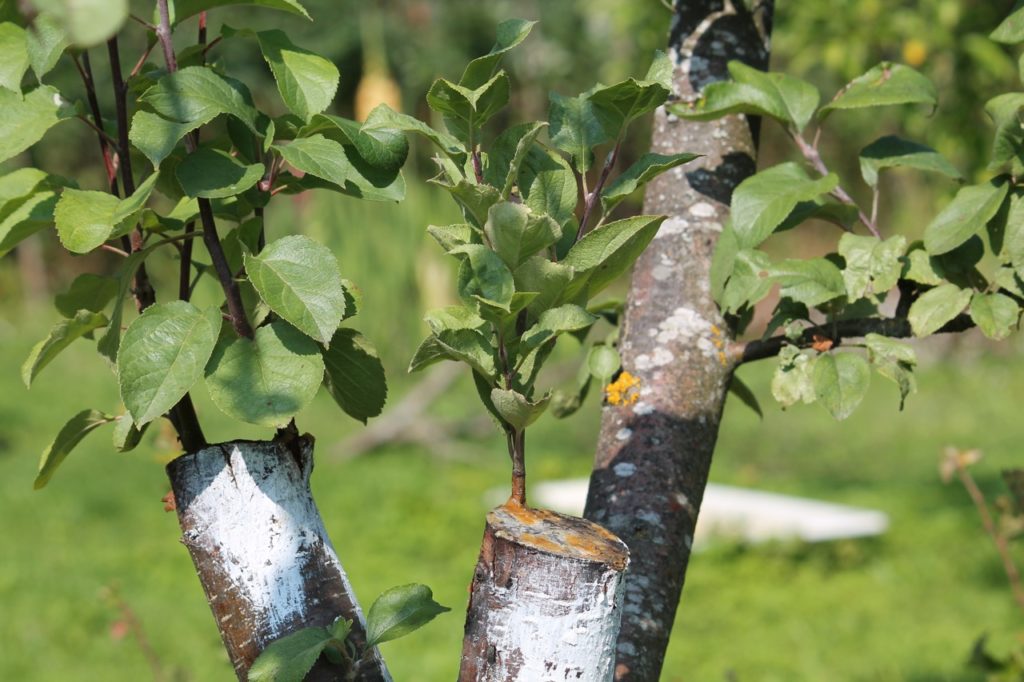
As well as growing apple trees as standard-form trees, it is also possible to train apple trees into different forms.
Apple trees lend themselves to cultivation even in smaller spaces because they can be trained to grow into space-saving and much more compact forms than those into which they would naturally grow.
“Do some initial pruning over the first few years, to shape your tree to a desired shape,” says Julie Bellemann from Sheffield Fruit Trees.
“If you do this in the early years, it will be easier to prune once it is more established.
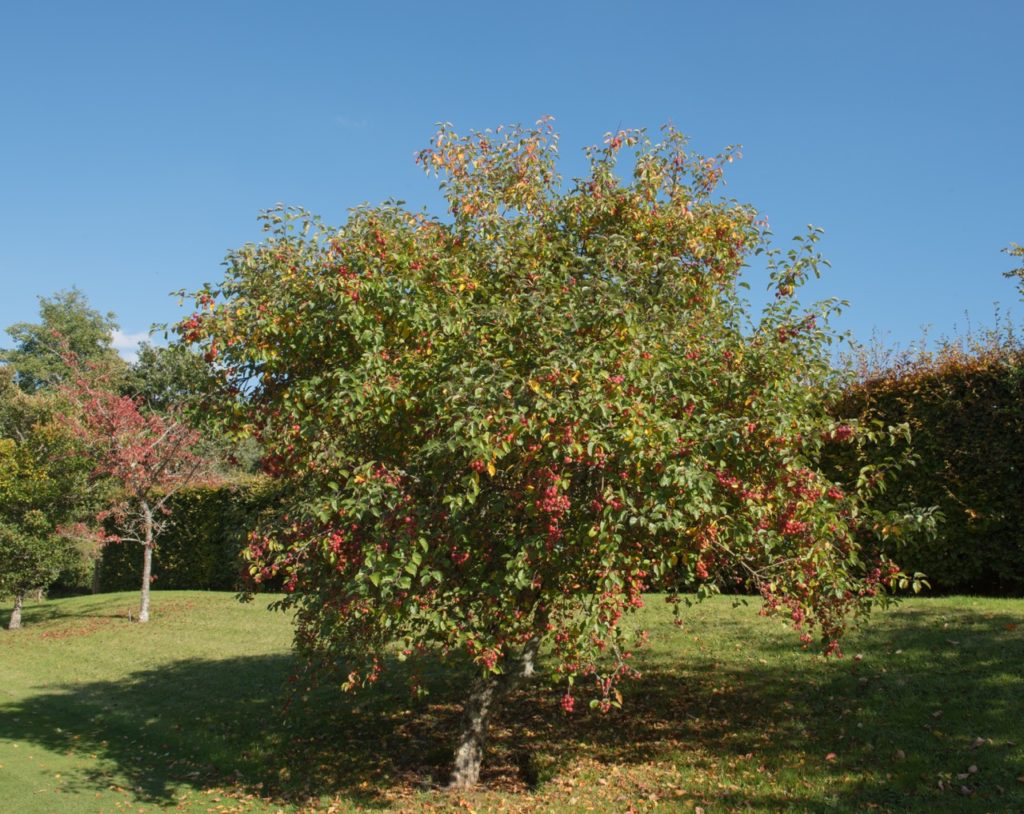
“If you have very little space, look into ways you can train your trees. Against a wall, fence or in a large pot are the best options.”
When it comes to the training and support of apple trees, there are, in fact, 5 main options:
- An espaliered form.
- A pleached tree.
- A fan-trained apple tree.
- Along a cordon.
- In a step-over form.
Read on for a little more information about each of the different growing forms.
Training & Support For Standard Apple Trees
If you are letting an apple tree grow in its naturalistic form, you will not need to worry a huge amount about training and support for your tree.
However, it is often a good idea to add a stake when initially planting your apple tree.
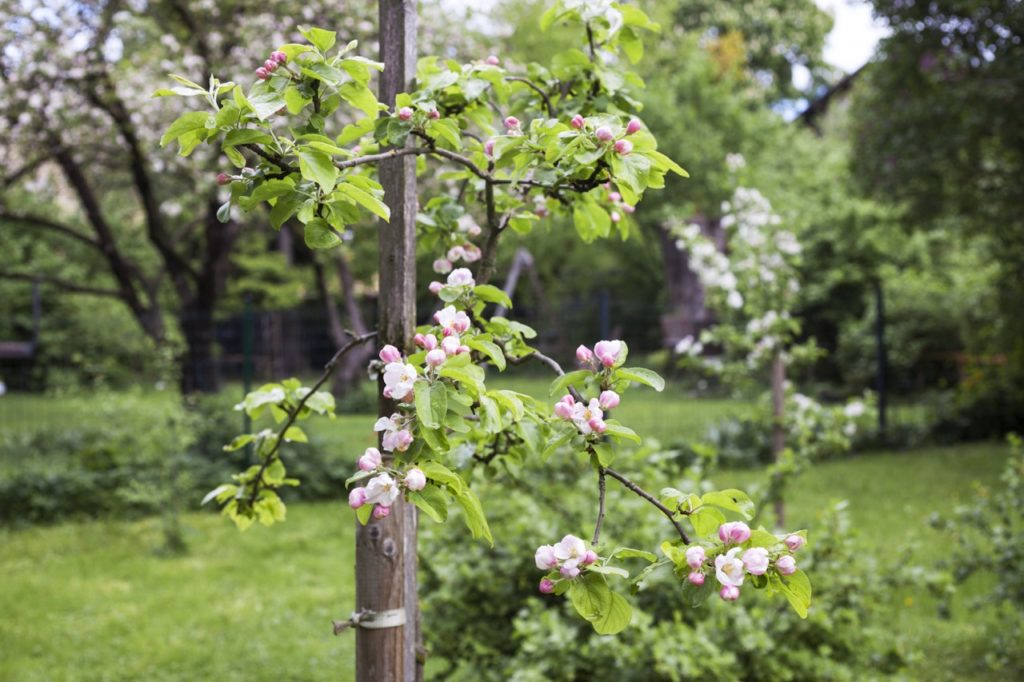
This will not typically be necessary if you are planting a smaller tree but can be beneficial if you are planting a taller variety that is more top-heavy.
Depending on the specific situation and tree, single staking, double staking or angled staking may be useful where required.
1) The Espaliered Form
When it comes to shaped forms for apple trees, the espalier is one option to consider.
Espaliered trees are trained and supported against a flat surface with a central trunk and several series of horizontal branches spreading out to both sides.
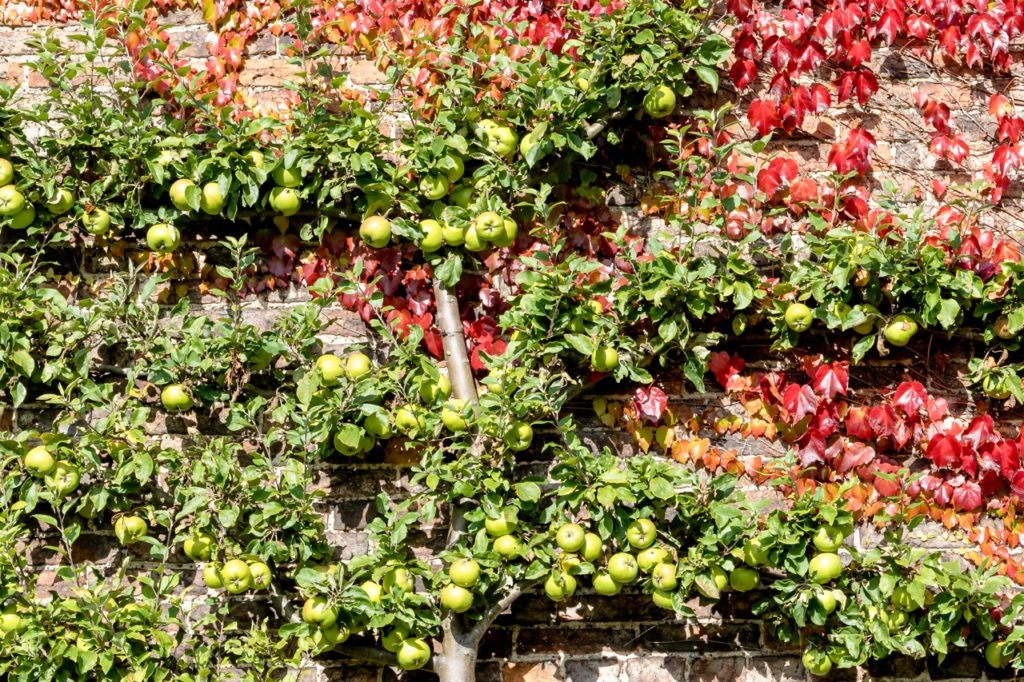
Espaliered trees are generally trained to grow along horizontal wires affixed to a wall or fence.
“I find espalier trained apples to offer the best option for a small garden, producing a good crop once established in a small pace,” shares Master Horticulturist Colin Skelly.
“They are also a great option for allotments or kitchen gardens, allowing them to be trained against walls or fences and freeing up space for other crops. They also look great!”
These should be spaced around 35-45cm apart and the lowest one should be 40cm above ground level.
A single-stemmed tree or partially pre-trained espaliered apple tree is then placed and tied into the supports.
Side stems are tied down to the horizontal support wires as they grow and all unwanted shoots are pruned back to just 2-3 leaves.
2) Pleached Apple Tree Support
Pleached apple trees are trained to have a long bare stem at the base, with branches spread out horizontally on either side of a central leader above a certain height.
This is a variation on the idea of an espaliered apple tree, but the space below allows light to come through, while perhaps enhancing the privacy in a particular part of a garden.
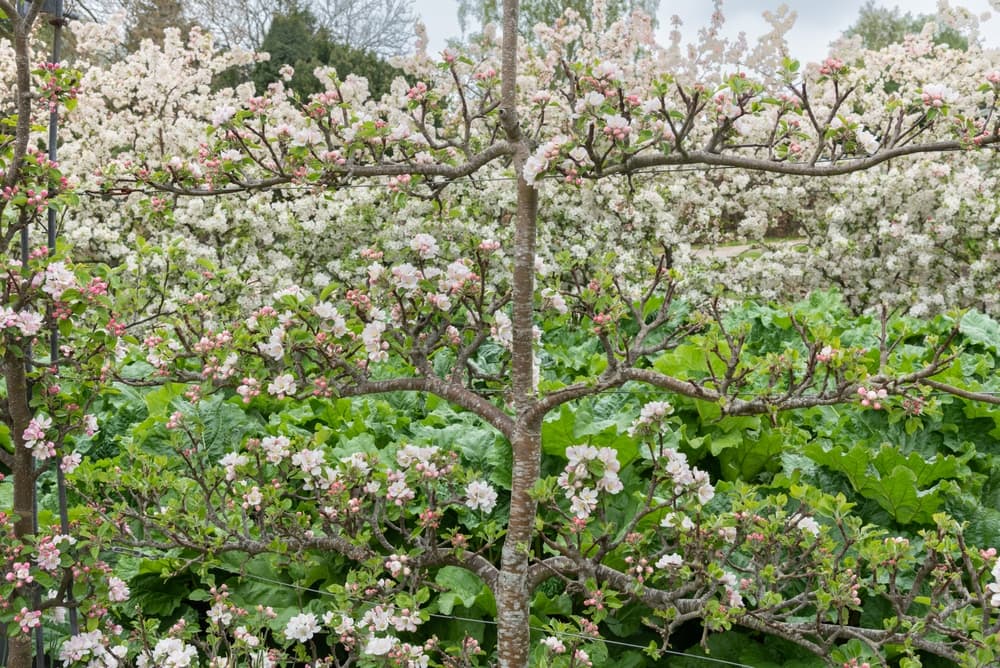
These are trained in much the same way as an espaliered apple tree, but, of course, a longer bare trunk at the base is maintained.
These are often purchased as fairly mature apple trees that have already been trained to give a near-instant impact.
3) Fan Training Your Trees
Fan-trained apple trees have a short trunk and a series of branches that radiate out like a fan above the said trunk.
This shape is often used up against a wall or fence in a garden to make the most of the space available.
Apple trees are best fan-trained in late winter or early spring before their buds open.

For fan training, apple trees with semi-dwarfing rootstocks are best.
Again, fans are trained to a series of horizontal wires on a wall or fence, though in this case, the wires should be around 15cm apart.
The initial training involves a specific series of steps involving tying in and pruning, which all depend on whether you are starting with a one or two-year-old tree.
Apple fans are pruned in late summer, unlike most apples which are pruned in the winter months.
This deters the re-growth of unwanted stems and encourages the formation of fruit buds.
The aim is to develop a system of short-fruiting spurs on a well-established framework of branches through pruning.
4) Cordon Apple Trees
Another option is to train apple trees into single tall and narrow vertical cordons.
Training an apple tree as a cordon involves allowing a single main growing stem to grow, with short fruiting spurs to either side.
Cordon apples are often grown on a wall, fence or other support structure at a 45° angle, though they can also be grown vertically or trained to meet and form an archway or tunnel over a pathway, which can make an extremely ornamental feature for a garden.
Cordon apples can be trained from scratch or purchased pre-trained.
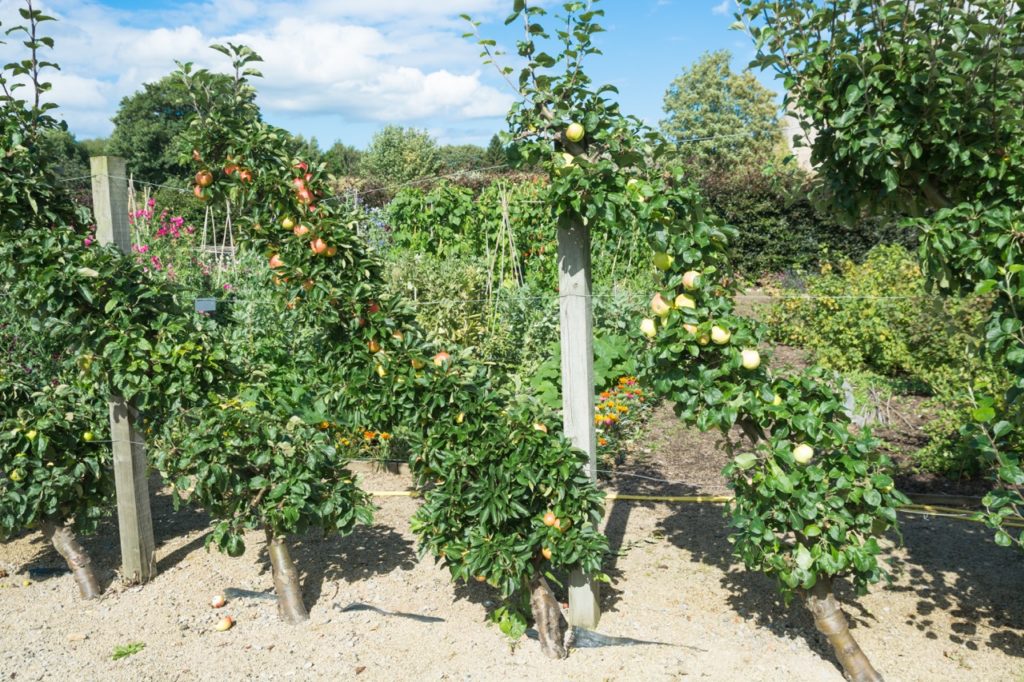
“Think about the size of your garden and how big you can let your tree grow,” explains Julie.
“Trees on vigorous rootstocks can easily grow 4-6 metres tall and wide, but by choosing more dwarfing stocks you can control this height and keep it smaller, perhaps by growing it along cordons.”
A dwarfing rootstock on a spur-bearing is typically used when apple trees will be trained in this way.
These trees will need permanent support and must be pruned carefully and correctly to maintain their shape and size.
The idea is to have a single main growing stem with short fruiting spurs along the sides, allowing the apple tree to retain a very compact and space-saving form.
5) The Step-Over Form
One final option is to train apple trees into a step-over form so that they form low hedging or bed edging that is only around 45-60cm in height.
This form is like the lowest tier of an espaliered apple tree, without any of the higher horizontal branches.
It will look great around the edges of a vegetable patch or cut flower beds in many gardens.
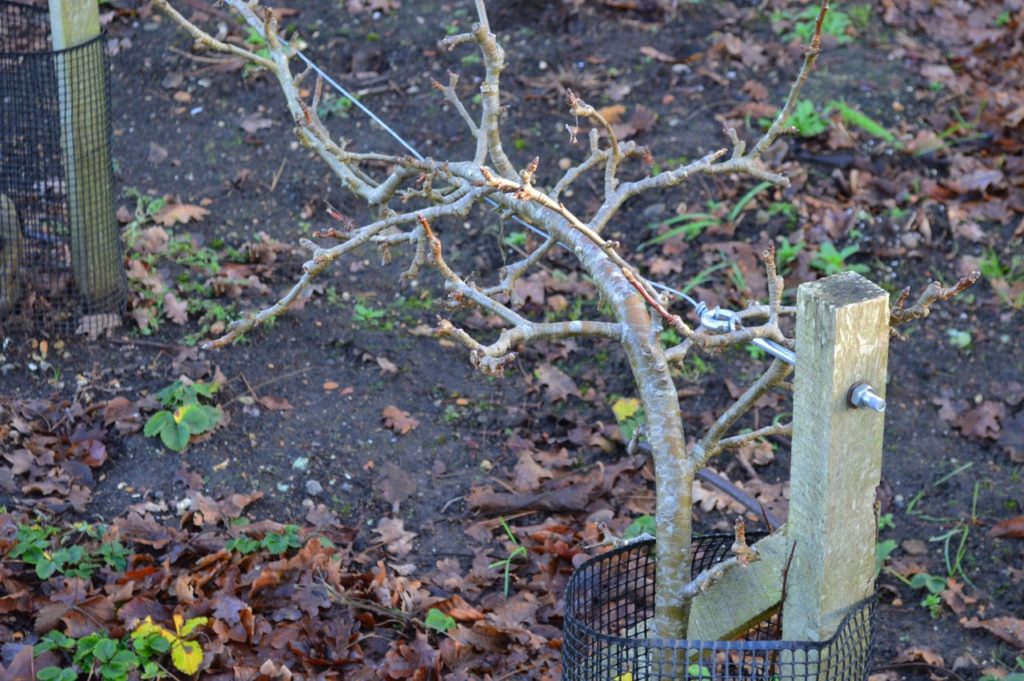
A low support structure is created and branches are trained out sideways from a short vertical stem along wires suspended a short distance above the ground.
Any growth trying to grow higher should be curtailed to keep everything growing low to the ground.
Understanding the different ways in which apple trees can be trained and supported as well as the different options that are on offer should make it clear just how versatile these trees can be and how space might be found for an apple tree of some kind in almost every garden.
